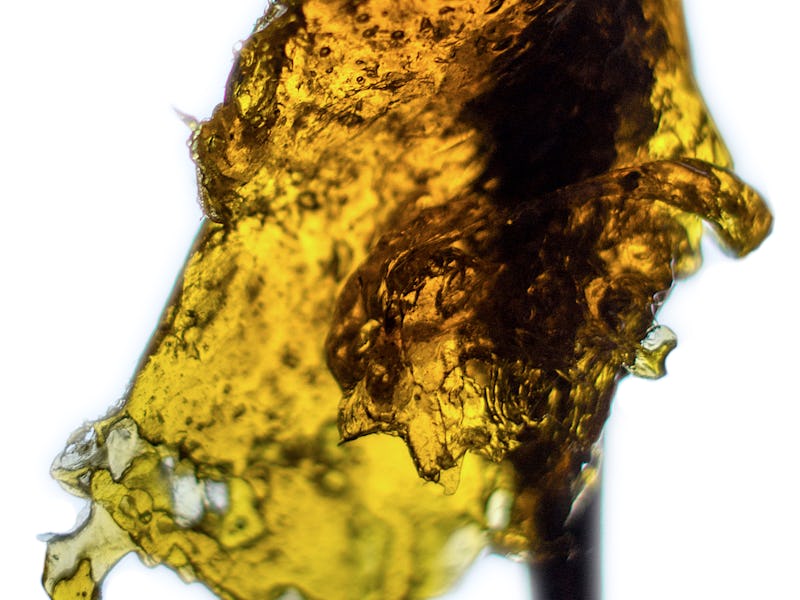Shatter Weed Is the Most Powerful Marijuana Concentrate
Let's do some chemistry.

Marijuana has reached unprecedented levels of potency these days, with concentrations of the active ingredient THC regularly exceeding 20 percent. But for those cannabis connoisseurs who really want to explore the extremes of cannabinoid consumption, smoking flowers simply won’t do the trick. For these adventurous and generally more experienced smokers, this is where concentrates come in. And when it comes to the various types of cannabis concentrates — among them, budder, wax, bubble melt hash, and honey oil — there are few that are stronger than shatter, which can knock you back with up to 80 percent THC.
Shatter gets its name from what it does when you drop it. As opposed to hash oil, which is sticky, or budder, which is waxy, shatter is hard and brittle like one of those pieces of strawberry hard candy your grandmother loudly unwraps at the movie theater. And just like granny’s hard candy, it can crack into a bunch of tiny pieces if you tap it too hard with your dabber.
Intrigued by this powerful pot compound? Here’s what else you need to know.
Bubble, bubble, toil, and trouble.
Extraction
Shatter is what’s known as a butane hash oil (often referred to as BHO), and as such, it starts life with a butane extraction. In this process, pressurized butane is injected into the top of a container that’s packed with finely ground marijuana flowers. The butane solution oozes into a collection tray, where the volatile butane quickly evaporates, leaving behind nothing but concentrated hash in a clear, homogenous state.
This rapid extraction is made possible by butane’s chemical properties: It’s a non-polar solvent that quickly evaporates at room temperature. The solvent property makes butane great for dissolving the active ingredients in marijuana — such as THC, CBD, THCA, and assorted terpenes (more on them later) — and washing them down into a receptacle. The plant material is left behind in the container and usually discarded.
A word of warning: Since butane is a highly flammable hydrocarbon, it’s not safe to do this in your home. Professional labs that produce shatter use specialized equipment, including ventilation hoods like you’d find in a chemistry lab. If you insist on producing DIY shatter in a PVC pipe with a coffee filter on the end, please please do it outdoors so you don’t blow up your kitchen or bathroom.
Okay, now that we’ve got the warnings out of the way and have a firm grasp on butane extraction, let’s talk about what makes shatter different from other concentrates.
Not your grandmother's candy.
Terpenes
One huge difference between shatter and its closest relatives is that shatter has a low concentration of terpenes. Terpenes are important to marijuana quality and differentiation because they’re responsible for the unique flavors and aromas of different varieties. But when it comes to shatter, they’re unwelcome.
Here’s the problem: Terpenes in the end product essentially function as solvents, making hash sappy instead of hard. This is fine if you’re making budder or hash oil, but when it comes to shatter, a higher level of purity is called for.
There are a couple of ways to get around this.
Shatter is not for lightweights.
Curing and Heating
Since a certain amount of terpenes often evaporate while marijuana flowers dry and cure, performing a butane extraction on flowers that have been cured will yield a lower concentration of terpenes in the final product. But there will usually still be some left after extraction. This is fine if you’re making budder or wax, both of which preserve the terpene profile of the flowers.
If you’re going for ultra-pure shatter, though, you’ll need to find a way to get rid of the terpenes and achieve that beautiful clear, glassy appearance. Fortunately, it’s simple: Just add heat.
Once the butane has evaporated, shatter producers often apply gentle heat to the concentrate — only about 98 degrees Fahrenheit or so — and some even do this in a vacuum chamber to suck away the terpenes as they evaporate. What you’re left with is shatter, a very stable and concentrated extract of cannabis.